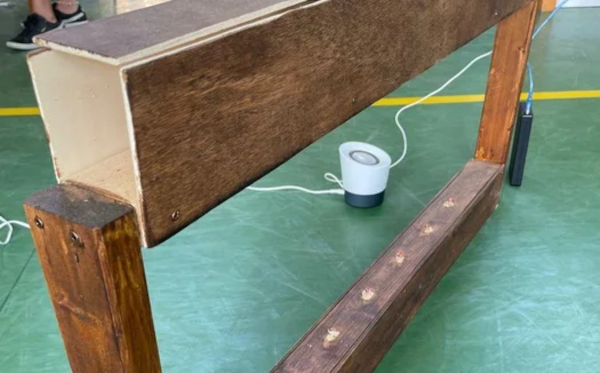We aren’t sure if you really need lasers to build [HoPE’s] laser harp. It is little more than some photocells and has an Arduino generate tones based on the signals. Still, you need to excite the photocells somehow, and lasers are cheap enough these days.
Mechanically, the device is a pretty large wooden structure. There are six lasers aligned to six light sensors. Each sensor is read by an analog input pin on an Arduino armed with a music-generation shield. We’ve seen plenty of these in the past, but the simplicity of this one is engaging.
We’ve used the copper tape writing trick ourselves and it is quite effective. The tape is often used for stained glass work and sticks to many surfaces. You can solder to it and solder overlaps where you need connections. The results are often as good as a simple single-sided PCB.
The code attached to the post is fairly straightforward and the MIDI shield does the bulk of the work. It should also make it easy to create some really impressive musical effects with a bit of extra coding.
If you want an artsy self-contained version, check out this previous Hackaday Prize entry. We’ve seen several of these at different levels of complexity.

















There’s a giant one of these at Meow Wolf in Santa Fe. Glad another exists. Thanks for the post.
Great to see someone complete such a project. Here’s my tale of not doing so:
Purchased the lasers for doing this. They’re in a box. One of those backburner projects that won’t happen even if I get several more lifetimes… Shame as lasers are cool. The wife purchased a real harp and I wanted something for the daughter (toddler at the time) to be able to play with without breaking or making sticky. So laser beams are the way forwards.
Toddler eyes are important, so confirmed with one of the laser safety guys at UKAEA (where I worked), that the tiny little red lasers were close enough to 1/2 mw to be eye OK. Got as far as winding down the current a little with a breadboard and an Arduino, just like this, to have even less power. Not measured but visibly much dimmer.
The goal though was to have interlinked oscillators rather than an Arduino for an analog synth sound. The box of bits is large but only partly populated before the project was canned. Was taking way too much time to design and as such would warrant a nice woodwork frame and take even more time.
So modded a lyre harp instead:
https://www.tdpri.com/threads/electric-lyre-harp.1018459/
Much fun through stacked delays with an enthusiastic 4 year old attacking it – for a while.
There is no safe laser for a toddler. Even a dimmed down de-focused 0.5mW.
Of course there is. Low enough power is low enough power. It was never finished so was a non issue, but efforts were to use the detectable limit of directional sensors. That discussion is far beyond a comments box. My daughters eyes are very important…
But rest assured, had it been finished, all light sources would have been measured individually and the circuit checked for safety.
Parental supervision is a thing also, as is the possibility of designing something she couldn’t get her head in (but big open frame was the desired way forward).
Eyes are log(ish) sensative, so dimming the beam by a factor of 10, makes it way safer without loosing little red dots on finger tips too much.
But without smoke, and lots of power, I guess some of the fun was lost. An unsafe laser harp which you can’t hold your hand in would be more amusing.
Al seems pretty negative about this project.
Not commenting on the practicality of actually playing such a thing, but: Why lasers?
If you’re going to use a fog machine to make the beams visible, OK, do it for the effect.
But if all you want is to interrupt a light beam, why not use plain old LEDs? They are used all the time for light curtains or “photon fences” for equipment guarding or elevator doors or touchless touchscreens, and can get sub-millimeter or parts-per-thousand position accuracy, and it’s almost trivial to get a meter gap. (though more than that requires ambient light control, optical filters, and/or signal conditioning circuitry)
Eye safe, and cheaper than lasers too.
I suppose the only gotcha is that you generally need to drive the LED array one at a time, instead of always-on like the collimated lasers could be.
“…why not use plain old LEDs?”
Because, lasers!
“I suppose the only gotcha is that you generally need to drive the LED array one at a time …”
This can be overcome by modulating the LEDs with different frequencies and using selective detectors, which also makes it much less susceptible to abient light. Could be done with one 555 and one 567 per “photon string”. That’s simple 1970s technology, except for today’s high output LEDs.
Jean Michel Jarre, Houston 1986. Wish I could have been at that concert.
https://www.youtube.com/watch?v=hRzzF-WObYE
About 8:30 in.
The one thing that baffles me is the use of a rectangular shape. If you’re going to call it a laser harp, then – surely – you’d make the frame approximately harp-shaped…no? Then you get the visual cues of low notes to high notes from the spacing.
Speaking of visual cues, putting the lasers on the bottom is a bad idea. Even if you don’t worry about looking into a laser with your remaining eye when sticking your head inside the frame, the red dots will be on the bottom of your fingers/feet/mice running over the lasers/whatever. At least put the lasers on top where you can actually see that you’ve affected something!
icstation sells a cheap laserharp kit with the lasers on top pointing down, but it only supports seven notes